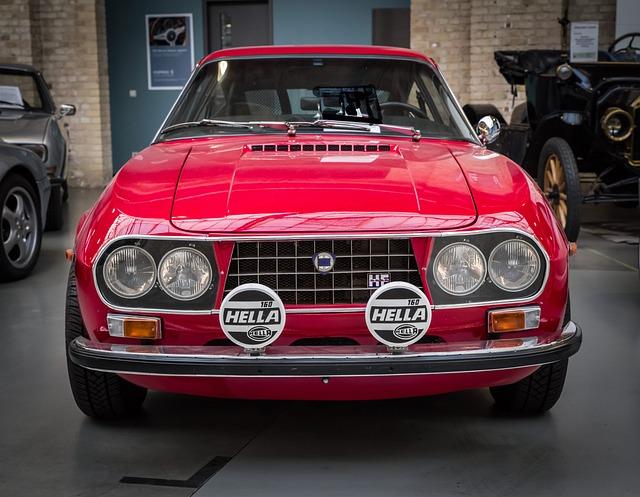In the pantheon of motorsport legends, few names evoke as much passion and nostalgia as Lancia Martini Racing. Born from the synergy between Italian automotive excellence and the fervor of competitive racing, this iconic team carved its niche in the annals of rally history during the late 20th century. With a dazzling blend of cutting-edge engineering and astute design, Lancia, adorned with the distinctive Martini Racing livery, became synonymous with speed, precision, and an indomitable spirit. This article embarks on a journey through the mesmerizing world of Lancia Martini Racing, exploring its roots, its triumphs, and the legacy it left in the fast-paced realm of motorsports. Join us as we delve into a story of innovation, camaraderie, and the relentless pursuit of victory that continues to inspire a new generation of racing enthusiasts.
Table of Contents
- The Legacy of Lancia Martini Racing in Motorsport History
- Iconic Designs and Liveries: Celebrating the Aesthetic Appeal
- Technological Innovations and Engineering Excellence
- The Future of Lancia Martini Racing: Embracing New Challenges
- Q&A
- Final Thoughts
The Legacy of Lancia Martini Racing in Motorsport History
Lancia Martini Racing has carved a remarkable niche in the annals of motorsport, forever intertwined with the excitement of rallying and the pursuit of speed. This iconic team, a collaboration between Lancia and Martini, dominated the World Rally Championship (WRC) during the 1980s and early 90s, achieving a stunning array of victories that not only showcased the engineering prowess of Lancia vehicles but also the strategic expertise of its drivers. Notable successes include:
- Six WRC Constructors’ Championships — cementing Lancia’s reputation as a titan in rally racing.
- Multiple Drivers’ Championships — highlighted by legends like Juha Kankkunen and Miki Biasion
- Iconic vehicles including the Lancia Delta S4 and the Delta Integrale, which became symbols of performance and innovation.
The team’s legacy is characterized by its blend of artistic design and technical excellence, which revolutionized rally car specifications. Lancia Martini Racing pushed the boundaries of what was achievable in motorsport, setting new benchmarks for speed and safety. To this day, the resonance of their achievements can be felt, inspiring a new generation of motorsport enthusiasts and engineers. Key contributions to motorsport include:
| Year | Event | Achievement |
|---|---|---|
| 1983 | WRC Champion | First year of dominance |
| 1985 | Group B Era | Introduced Delta S4 |
| 1992 | Last Title | Victory list capped with a final championship |
Iconic Designs and Liveries: Celebrating the Aesthetic Appeal
Throughout the history of motorsport, few designs have captured the imagination of racing fans quite like Lancia Martini Racing. The iconic blue, white, and red color scheme not only represents a brand but evokes a visceral connection with the heart-pounding world of rally racing. The stunning livery is synonymous with speed and sophistication, making it an enduring symbol on every circuit it graced. Each detail, from the bold Martini logo to the sleek lines of the Lancia Delta HF Integrale, blended aesthetic beauty with high-performance engineering, creating a visual language that spoke to the spirit of competition.
The strategic use of color and brand placement in their vehicles offers a masterclass in design philosophy. The harmonious balance of contrast and coherence draws the eye, ensuring that Lancia cars remained striking on the track and in the paddock. To illustrate this aesthetic allure further, consider the table below highlighting memorable aspects of the Lancia Martini Racing livery:
| Feature | Description |
|---|---|
| Color Palette | Distinguished blue, white, and red |
| Logos | Prominent Martini branding, creating instant recognition |
| Design Elements | Sleek lines, aerodynamic curves, cohesive flow |
| Historical Significance | Showcased success in rally championships globally |
In racing, the aesthetic appeal goes hand in hand with functionality. Lancia Martini Racing embraced this synergy, demonstrating that beauty and performance can exist in perfect harmony. The livery not only served as a marketing tool but also as a visual representation of triumph, ambition, and the relentless pursuit of speed, marking it as one of the most recognizable and celebrated designs in motorsport history.
Technological Innovations and Engineering Excellence
The rich heritage of Lancia Martini Racing is a testament to the synergy between technological innovation and engineering excellence. Over the years, the team has pioneered numerous advancements in automotive technology, particularly in the world of rally racing. By integrating cutting-edge materials, such as lightweight composites, and state-of-the-art aerodynamics, Lancia has consistently pushed the boundaries of performance. This relentless pursuit of innovation has led to winning numerous championships, showcasing how the right blend of creativity and precision engineering can achieve remarkable feats on the road and track.
Key to Lancia’s success has been its commitment to research and development, which has translated into several groundbreaking features that have redefined rally racing. Some of these advancements include:
- All-Wheel Drive Systems: Enhancing traction and control on various terrains.
- Advanced Suspension Technologies: Providing superior handling and stability.
- Telemetric Data Analysis: Enabling real-time monitoring of vehicle performance.
These innovations are not merely cosmetic; they represent a philosophy that emphasizes precision, reliability, and speed. The legacy of Lancia Martini Racing continues to inspire future generations of engineers and designers, proving that excellence in engineering can indeed fuel the spirit of competition.
The Future of Lancia Martini Racing: Embracing New Challenges
As Lancia Martini Racing seeks to chart a course for the future, it is essential to embrace the evolving landscape of motorsports and automotive technology. The team’s rich legacy in rallying and endurance racing serves as a foundation for innovative strategies that cater to new challenges. By integrating modern advancements such as hybrid technology, data analytics, and sustainability initiatives, Lancia is positioning itself to remain competitive in an increasingly complex arena. This approach not only preserves the brand’s iconic heritage but also showcases a commitment to adapting to the demands of future racing disciplines.
To achieve its ambitious goals, Lancia Martini Racing plans to focus on several key areas:
- Talent Development: Nurturing a new generation of drivers and engineers.
- Collaborative Ventures: Partnering with tech companies to incorporate breakthrough innovations.
- Fan Engagement: Utilizing digital platforms to enhance spectator experiences and forge deeper connections.
These initiatives will be supported by a structured roadmap, aiming for a seamless integration of traditional racing values with cutting-edge practices. Below is a concise overview of Lancia Martini Racing’s strategic priorities:
| Priority Area | Description |
|---|---|
| Technology Integration | Adopting hybrid and electric technologies for race vehicles. |
| Research and Development | Investing in innovative materials and aerodynamics. |
| Global Expansion | Exploring opportunities in emerging markets. |
Q&A
Q&A: All About Lancia Martini Racing
Q1: What is Lancia Martini Racing?
A1: Lancia Martini Racing is a motorsport team that emerged from the collaboration between the Italian automobile manufacturer Lancia and the Martini brand, primarily known for its vermouth. The partnership, which began in the late 1970s, is best known for its dominance in the World Rally Championship (WRC) during the 1980s.
Q2: What made Lancia Martini Racing so successful in rallying?
A2: The team’s success stemmed from a combination of innovative engineering, talented drivers, and strategic direction. Vehicles like the Lancia Stratos and later the Delta S4 combined lightweight design with powerful engines and advanced technology for the time. This, paired with sharp driving skills from legends such as Sandro Munari and Henri Toivonen, ensured Lancia’s stature as a favorable contender in the rally scene.
Q3: Can you highlight some of the team’s significant achievements?
A3: Certainly! Lancia Martini Racing achieved remarkable milestones, including securing multiple Drivers’ and Manufacturers’ Championships in the WRC. Notable successes include the Lancia Delta Integrale’s back-to-back titles in the late 1980s, culminating in a legendary era that saw the team win six Manufacturers’ Championships between 1987 and 1992—a record that still stands.
Q4: How did the collaboration with Martini impact the team’s branding?
A4: The partnership with Martini introduced a distinctive and vibrant livery that became iconic in motorsport. The bold use of blue, red, and white created an instantly recognizable brand image on the rally stages. This visual appeal, combined with Martini’s strategic marketing efforts, elevated both the team and its sponsors within popular culture.
Q5: What are some of the challenges faced by Lancia Martini Racing during its prime?
A5: Despite its successes, the team faced significant challenges, including intense competition from rivals such as Audi, Peugeot, and Subaru, especially as technology in rallying rapidly evolved. Additionally, evolving regulations and the shift towards Group A regulations at the end of the 1980s required Lancia to adapt its strategies and vehicles, testing the limits of their technical capabilities.
Q6: What is the legacy of Lancia Martini Racing?
A6: The legacy of Lancia Martini Racing is profound in both motorsports and automotive history. The team’s innovative spirit and competitive achievements have inspired countless drivers and manufacturers in rallying and beyond. Enthusiasts and collectors still celebrate the cars, and they remain popular at vintage rallies and racing events, epitomizing an era of thrilling motorsport.
Q7: Are there any contemporary influences of Lancia Martini Racing in today’s motorsport?
A7: While Lancia’s presence in international motorsport has diminished since the early 1990s, the spirit of Lancia Martini Racing lives on. Current teams often pay homage to Lancia’s legacy through retro designs and references, while the principles of innovation and performance established by the Lancia Martini era continue to influence modern rally car development and racing strategies in the WRC.
This Q&A provides a concise yet comprehensive understanding of Lancia Martini Racing, shedding light on its history, impact, and enduring legacy within motorsport.
Final Thoughts
In the grand tapestry of motorsport history, Lancia Martini Racing stands out as a vivid thread woven with ambition, innovation, and triumph. From its thunderous presence on the rally stages to its iconic vehicles that captured the hearts of enthusiasts worldwide, this partnership redefined boundaries and reshaped the very essence of racing. The resonance of Lancia Martini Racing continues to echo in the corridors of automotive nostalgia, sparking inspiration for new generations of racers and fans alike. As we reflect on this remarkable legacy, we are reminded that in the world of speed, passion, and precision, every lap tells a story—and the stories of Lancia Martini Racing are among the most thrilling chapters in the book of motorsport. Whether you are a seasoned fan or a newcomer intrigued by the artistry of rallying, Lancia Martini Racing invites you to embrace the spirit of competition and celebrate a legacy that endures beyond the finish line.



